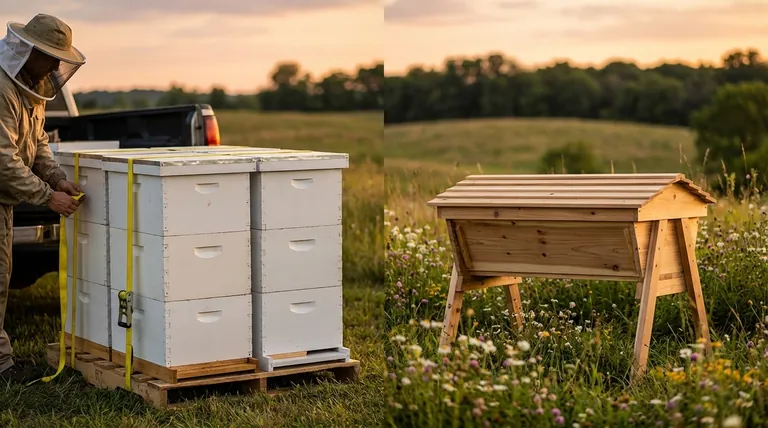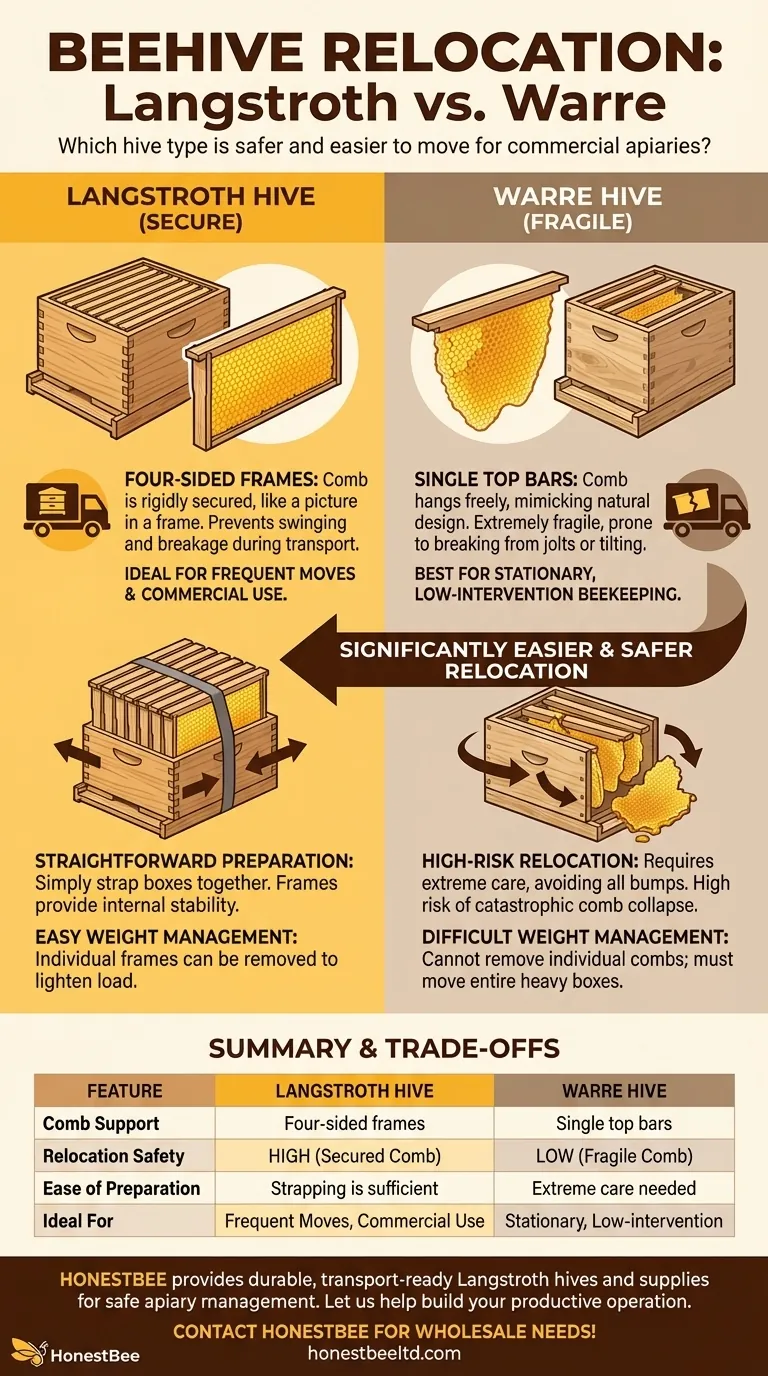In short, the Langstroth hive is significantly easier and safer to relocate than the Warre hive. This is almost entirely due to the fundamental difference in how each hive supports the honeycomb. A Langstroth uses four-sided frames that secure the comb, while a Warre uses simple top bars from which the comb hangs freely, making it extremely fragile during transport.
Moving a beehive is inherently disruptive to the colony. The central challenge is to transport the hive without the internal honeycomb structure breaking apart. The Langstroth hive's frame system is engineered to solve this problem, whereas the Warre hive's top-bar design makes relocation a high-risk activity.

The Core Difference: Frames vs. Top Bars
The ease of relocation comes down to one critical component: how the wax comb is supported inside the hive.
Langstroth Frames: Engineered for Stability
Langstroth hives use rectangular frames, typically made of wood or plastic, that surround the comb on all four sides. The bees build their comb attached to the top, bottom, and often the side bars of this frame.
This design functions like a picture in a picture frame. The comb is held rigidly in place, preventing it from swinging, shifting, or breaking during movement. This structural integrity is the primary reason Langstroth hives are the global standard for commercial beekeeping and pollination services, which require frequent moves.
Warre Top Bars: A Naturalist, but Fragile, Design
Warre hives do not use frames. Instead, they use simple wooden bars that sit across the top of each hive box. The bees build their comb naturally, drawing it down from this single point of attachment.
This results in a beautiful, natural comb that hangs freely inside the box, similar to how bees would build in a hollow tree. While this supports a more "natural" beekeeping philosophy, it makes the comb exceptionally vulnerable during transport. Any significant jolt or tilt can cause the heavy, wax-and-honey-filled comb to break off the top bar.
Practical Implications for Relocation
This structural difference has direct consequences when you need to move your bees.
Securing the Hive for Transport
With a Langstroth hive, preparing for a move is straightforward. You simply ensure the frames are pushed together and then strap the hive boxes tightly to one another and to the base. The frames themselves provide all the internal stability needed.
With a Warre hive, strapping the boxes together does nothing to secure the fragile comb inside. The risk of internal damage remains extremely high. The only way to move a Warre hive with a degree of safety is to do so with extreme care, avoiding all bumps and tilting, which is often impractical.
Managing Hive Weight
Both hive types can become very heavy when full of honey. A key advantage of the Langstro Aynı, a key advantage of the Langstroth hive is its modularity. If a hive is too heavy to lift, the beekeeper can open it and remove several frames of honey to lighten the load before moving.
This is not an option with a Warre hive. The combs are not individually removable. Your only choice is to move the entire, heavy box or remove a whole box, which might disrupt the colony's brood nest.
Colony Stress and Comb Damage
The greatest risk in moving a Warre hive is catastrophic comb collapse. If a comb breaks, it can fall onto other combs below, causing a domino effect.
This crushes bees, can kill the queen, and spills honey and brood throughout the hive. A major comb break during a move is often an unrecoverable disaster for the colony. The secure frames of a Langstroth hive almost completely eliminate this risk, making relocation a far less stressful event for both the bees and the beekeeper.
Understanding the Trade-offs
Your choice of hive depends on your goals, and each system has a different philosophy.
Why Choose a Warre Hive? The Low-Intervention Approach
The Warre hive was designed to be a "people's hive," promoting a beekeeping style with minimal inspections and interventions. Its design is intended to mimic a natural bee habitat. For a beekeeper who intends to keep bees in a fixed location and prioritizes natural comb development above all else, it is a valid choice.
Why Choose a Langstroth Hive? The Management Advantage
The Langstroth hive is designed for active management. Its system of removable frames makes inspections, disease management, honey harvesting, and relocation straightforward and safe. It provides the beekeeper with maximum flexibility and control.
Choosing the Right Hive for Your Relocation Needs
Ultimately, you must weigh beekeeping philosophy against practical requirements.
- If you anticipate moving your hives frequently (e.g., for pollination, following nectar flows, or moving homes): The Langstroth is the only practical and safe choice due to its secure, transport-ready frame design.
- If your hives will be stationary and your focus is on low-intervention, natural beekeeping: The Warre hive is a viable option, but you must accept the significant challenges and risks if an unexpected move ever becomes necessary.
Your choice of hive should be dictated not just by beekeeping philosophy, but by the practical realities of managing and moving your colonies safely.
Summary Table:
| Feature | Langstroth Hive | Warre Hive |
|---|---|---|
| Comb Support | Four-sided frames | Single top bars |
| Relocation Safety | High (comb is secured) | Low (comb is fragile) |
| Ease of Preparation | Strapping boxes is sufficient | Requires extreme care to avoid tilting |
| Ideal For | Frequent moves, commercial use | Stationary, low-intervention beekeeping |
Need durable, transport-ready beekeeping equipment for your apiary?
As a leading wholesale supplier to commercial apiaries and distributors, HONESTBEE provides the robust Langstroth hives and reliable supplies you need for safe, efficient hive management and relocation. Let us help you build a more productive and resilient operation.
Contact HONESTBEE today to discuss your wholesale needs!
Visual Guide

Related Products
- Long Langstroth Style Horizontal Top Bar Hive for Wholesale
- HONESTBEE Professional Multi-Functional Hive Tool with Ergonomic Wood Handle
- Top Bar Beehive for Beekeeping Wholesales Kenya Top Bar Hive
- HONESTBEE Advanced Ergonomic Stainless Steel Hive Tool for Beekeeping
- HONESTBEE Professional Long Handled Hive Tool with Precision Cutting Blade
People Also Ask
- What is a top bar bee hive? A Natural, Low-Stress Beekeeping Solution
- What are the main differences between Langstroth hives and top bar hives? Choose the Right Hive for Your Beekeeping Goals
- What are the box management requirements for a top bar hive vs. Langstroth? Choose Your Hive Strategy
- How does the top bar hive help control varroa mites? A Natural Approach to Mite Management
- How does the design of a top bar hive benefit beekeepers? Ergonomic & Natural Beekeeping for Hobbyists



















